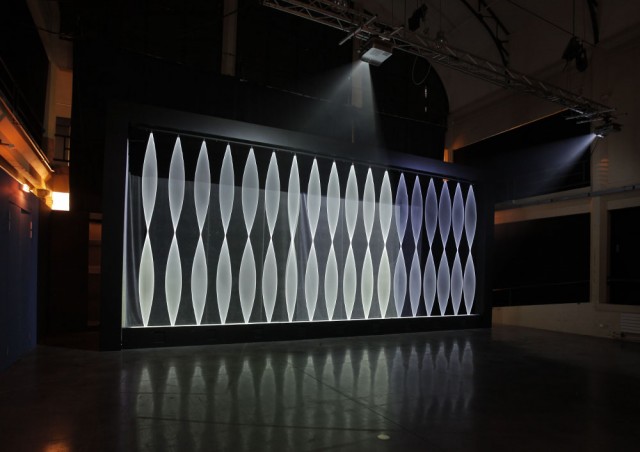Looking Outwards (MaxMSP)
Tripwire (2011)
 Tripwire by Jean-Michel Albert and Ashley Fure
Tripwire by Jean-Michel Albert and Ashley Fure
Tripwire is a set of 18 or 24 (depending on which installation) strings attached to motors. By spinning the motors at certain frequencies, and projecting light onto them, a captivating audio visual display is created. I specifically like that the colors projected onto the strings create the appearance of a volumetric light similar to a light projected into fog, but with much more defined boundaries. I find it interesting that the audience influences the piece by moving in front of it. This is done using infrared sensors that trach the presence of viewers.
I wonder though what this project would have been like if rather than rotating the strings were moved back and forth. I think that there would have been a possiblility to give the piece more tone, by vibrating at appropriate frequencies, rather than just whirring.
Tele-Present Water
This is a project where the artist David Bowen, simulates the movement of water in a grid sculpture controlled by maxMSP, Arduinos, and some DC motors. It collects data from the actual topology in the ocean near a buoy station in Alaska, scales it down, and displays it in the grid.
I liked this installation because I have always been fascinated by the movement of water. I find it interesting that the artist chose to simulate the fluid movement of water in a rigid grid. The installation reminds me of a wireframe of a video game terrain. However, the sculpture does appear to be slightly jittery. I think I would enjoy seeing it in a larger scale moving more “fluidly”.
Electric Stimulus
Daito Manabe has created a piece in which he associates a facial expression to sounds by forcing an expression on another persons face using electrodes that are activated differently depending on which finger is used to touch the other person. I’m not sure but this seems kind of dangerous. However, it is very interesting. I did notice that a finger is associated with a sound and facial expression, but the spot where the other person is touched is not. I would think that the project would be more interesting if the “instrument” reacted differently depending on where it was touched. It would also be interesting to see this paired with swept frequency capacitive sensing rather than single frequency binary capacitive sensing like they are using. For an example of swept frequency capacitive sensing, please see Touché.